
By now, I’ve introduced you to a lot of different ways to classify stars.
Months ago, I talked about the different spectral classes—O, B, A, F, G, K, and M. Even before that, I told you about apparent visual magnitude, our ranking system for how bright stars appear to the naked eye.
More recently, we explored absolute visual magnitude and the related absolute bolometric magnitude and luminosity. All these are related to a star’s actual brightness, not just how bright they seem to be from Earth.
And last but not least, we talked about the H-R diagram and how to rank stars by their luminosity classification.
In short, it may seem like sorting stars is a complicated business. But it’s not really. And here, I intend to give you an overview to put all this together.
Apparent vs. Absolute Visual Magnitude
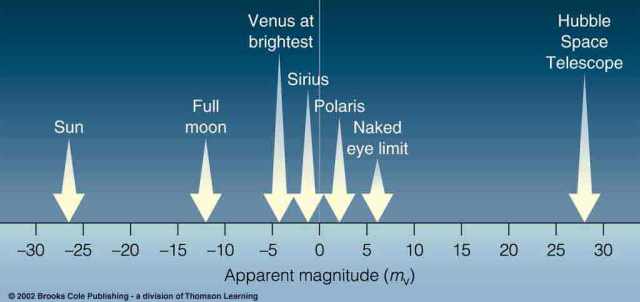
Apparent visual magnitude is a scale used to rank stars according to how bright they appear to the naked eye…from Earth. That’s an important distinction, because depending on how far away they are, that might not have anything to do with their real brightness.
Take the sun, for example—it’s actually fainter than Polaris, the North Star, but as you can see on the apparent magnitude scale, it looks a whole lot brighter. That’s because we’re 133 parsecs away from Polaris (really far), and less than a hundred thousandth that distance from the sun.
It’s like seeing a car’s headlights switch on in your driveway…versus watching the headlights streak by on the freeway a mile or so away. The one in your driveway looks a whole lot brighter, isn’t it? But it isn’t really—it’s just closer.
(For a more detailed explanation of apparent visual magnitude, see my post on it.)
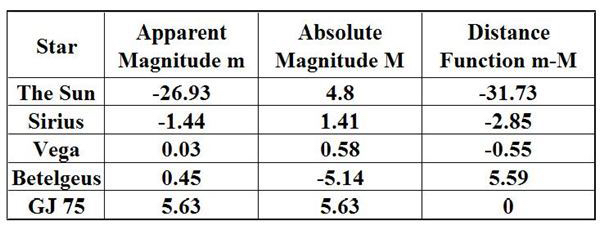
Absolute visual magnitude, on the other hand, refers to how bright any star would look from 10 parsecs away.
Polaris isn’t on this chart, but it has an absolute magnitude of about -3.64. Its apparent magnitude, on the other hand, is much fainter—only 1.97. Again, this is because it’s very far away.
It might surprise you, but the sun is actually a very faint star. How would it look from 10 parsecs away, rather than our measly 93 million miles? On a clear, dark night, you’d be able to see it well enough, but until 10 or 11 pm, it would be hopeless.
We don’t see the sun at night at all. But that’s only because our “night” is an arbitrary word for the dark side of Earth, the side that’s not getting the sun’s light. Imagine if, in the daytime, you could barely see the sun.
That’s actually what the sun looks like from the more distant planets, like Uranus and Neptune. They may not be even so much as a light year away from the sun, but they’re much farther than we are, so they experience a seemingly fainter sun.
Absolute Bolometric Magnitude & Luminosity
Absolute visual magnitude is all well and good, but we’re not taking into consideration most of the light coming from any star.
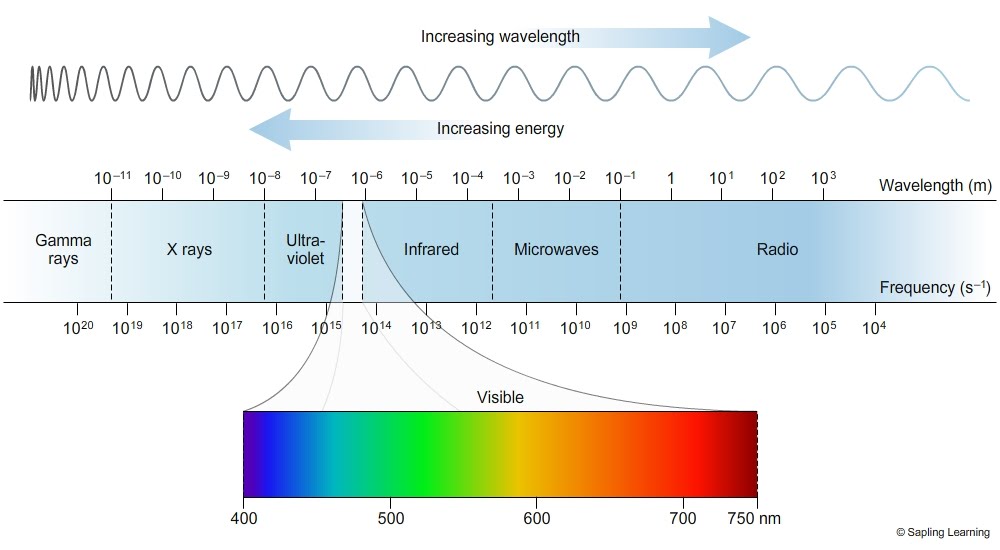
This is the electromagnetic spectrum, the spectrum of all radiation. Humans have evolved to see a tiny fraction of it that we know as “visible light.” The rest is invisible, but we do feel infrared radiation as heat.
When we rank stars according to their apparent and absolute visual magnitude, the operative word is visual. We’re only talking about that tiny chunk of the spectrum. If our eyes could see all radiation emitted by any one star, it would appear much brighter.
Absolute bolometric magnitude adjusts for the missing radiation and ranks stars according to their full brightness…even though our eyes can’t register it.
Luminosity takes that a step further and gives us the actual energy output of any star, rather than numbers on a ranking system.
The difference is that luminosity has units, like meters or feet, except that it uses joules. Absolute bolometric magnitude is just numbers—like the ones for apparent and absolute visual magnitude. It’s used to compare stars, not to really describe them.
Star Types & the H-R Diagram
“Star types” refers to whether a star is a white dwarf, main sequence star, giant, supergiant, or other recently discovered type of star.

We know what type any star is by looking at its spectrum. That’s a band of all the light it emits—like we just said, the entire electromagnetic spectrum. Except because we’re not looking at pure light, but stars, we’re not going to see a perfect rainbow.

What you’re seeing above are spectral lines on a star’s spectrum. They appear where certain materials in the star’s atmosphere block certain wavelengths of light, showing us what the star is made of.
Because certain materials can only exist in stars of certain temperatures, these spectral lines can act as a thermometer…allowing us to calculate the temperatures of stars.
Stellar spectra give us the power to figure out the temperature and composition of any star we can observe with a spectrograph. And with the help of luminosity, we can plot it on the H-R diagram.

The H-R diagram tells us a lot about a star. There are a lot of details about stars you can plot on it; it’s useful in that it can relate a lot of qualities found in stars, and thus compare them more thoroughly.
Some H-R diagrams are drawn more simply, showing less information. You can pick and choose what you show.
This one shows “lines of constant radius” at one solar radius, ten solar radii, and so on—that’s showing you how many times bigger or smaller than the sun any one star on this diagram is.
It also shows star temperatures, ranging from hottest at the left to coolest at the right—arbitrarily defined by the spectral classes, O through M.
You can even plot the absolute visual magnitude on here…
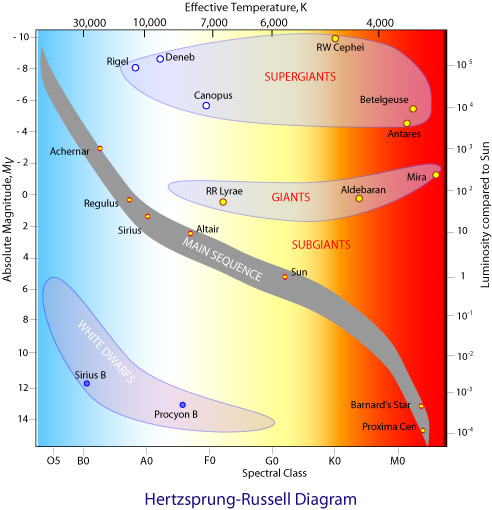
On this H-R diagram, the luminosity scale is on the right, but tells you the same thing about the stars. The absolute visual magnitude scale is on the left, lined up so it easily compares to luminosity.
Notice that for any one star, luminosity is greater than absolute visual magnitude. Like we discussed above, that’s because luminosity takes into account more of a star’s radiation than visual magnitude—in fact, all of it.
Luminosity Classes
And last but not least, the luminosity classes are another way to classify stars. You can find all luminosity classes on the H-R diagram, too…

In this H-R diagram, luminosity is labeled as “absolute brightness,” but it’s referring to the same thing.
The “main sequence,” or class “Ⅴ,” line through this diagram should be easy to match up with the same plot of stars in the other versions of the diagram above. They’re the least luminous luminosity class.
Luminosity classes Ⅱ, Ⅲ, and Ⅳ are the bright giants, giants, and subgiants. They fall into the general “giants” category on the other diagrams.
And classes Ⅰa and Ⅰb refer to the supergiants and bright supergiants—which are the same as the general “supergiants” category.
You can also tell a star’s luminosity class from its spectrum.
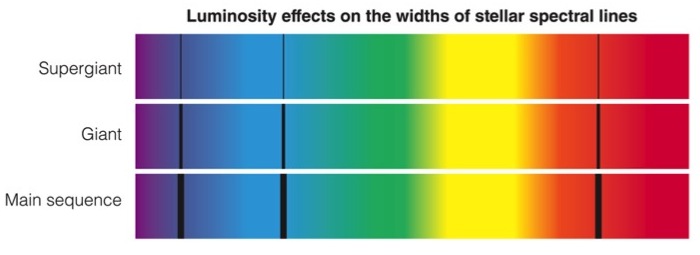
Star size—and, consequently, star type—has a dramatic effect on spectral lines. They are broader in smaller stars. (You’ll find my explanation of why that is in my post on the luminosity classes.)
(And yes…giants and supergiants are named for their size as much as for their location on the H-R diagram.)
See? Stars aren’t that complicated, and these sorting methods are helpful, rather than confusing. I thought I should give you a brief overview just to demystify things a bit before we dive into binary stars.